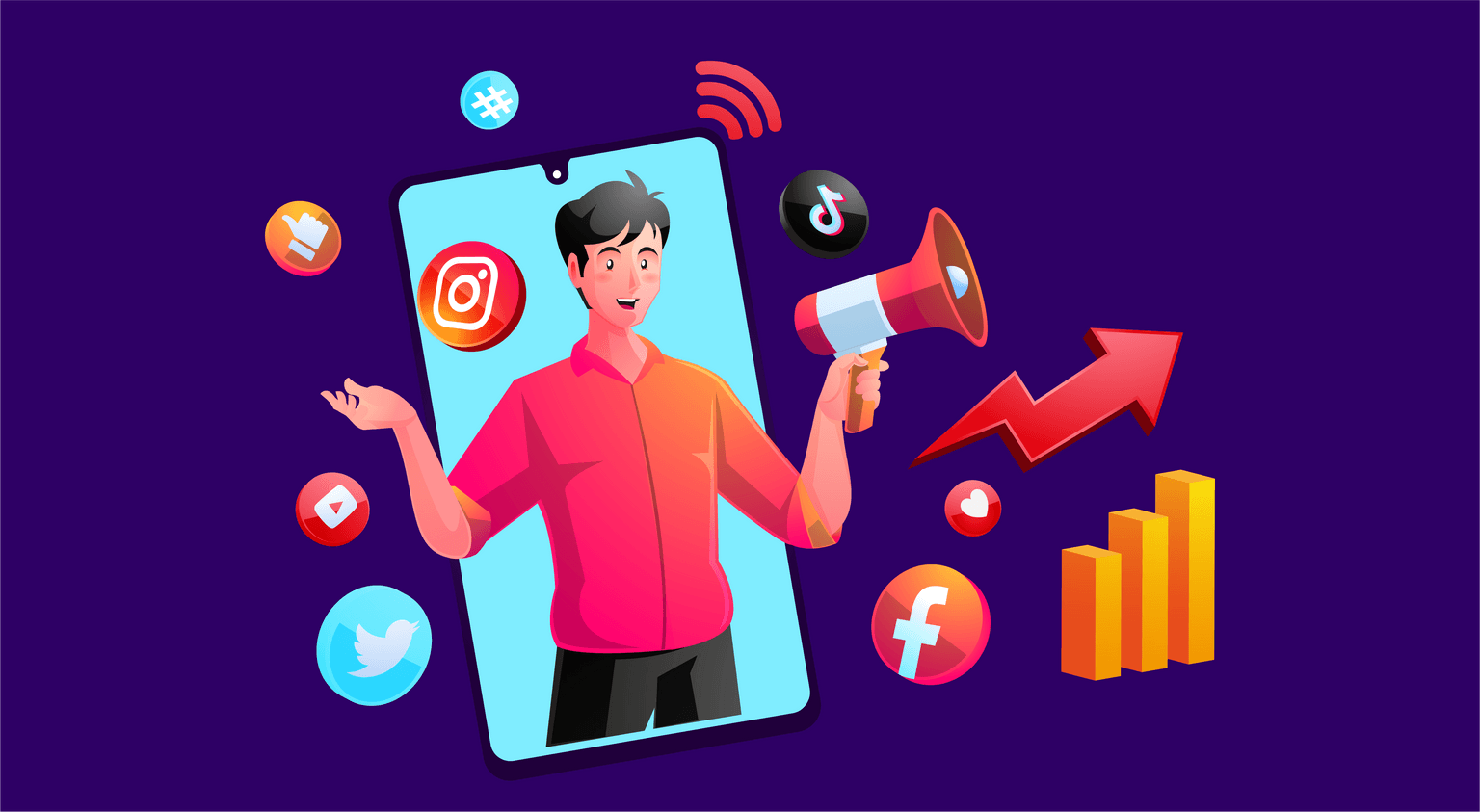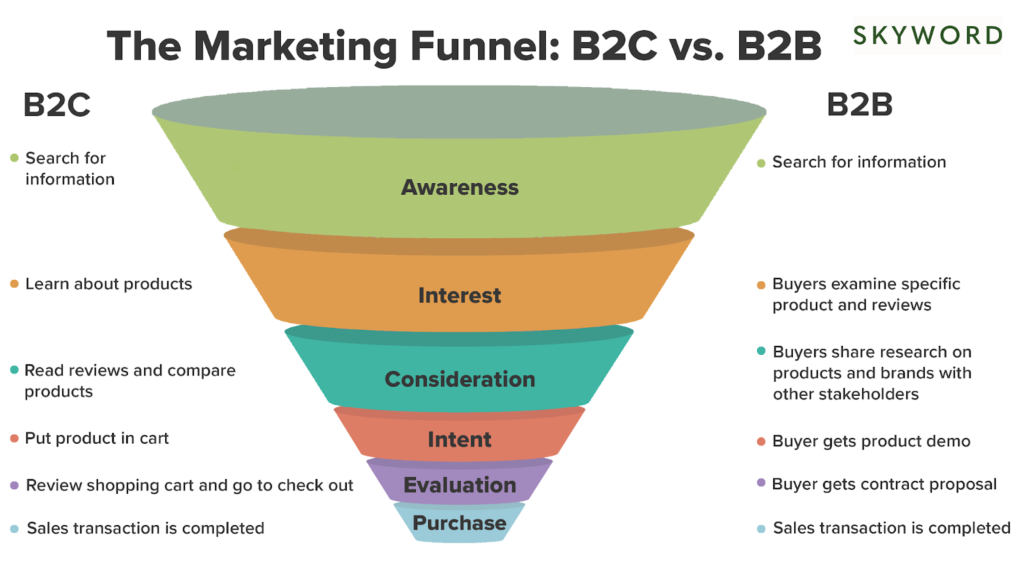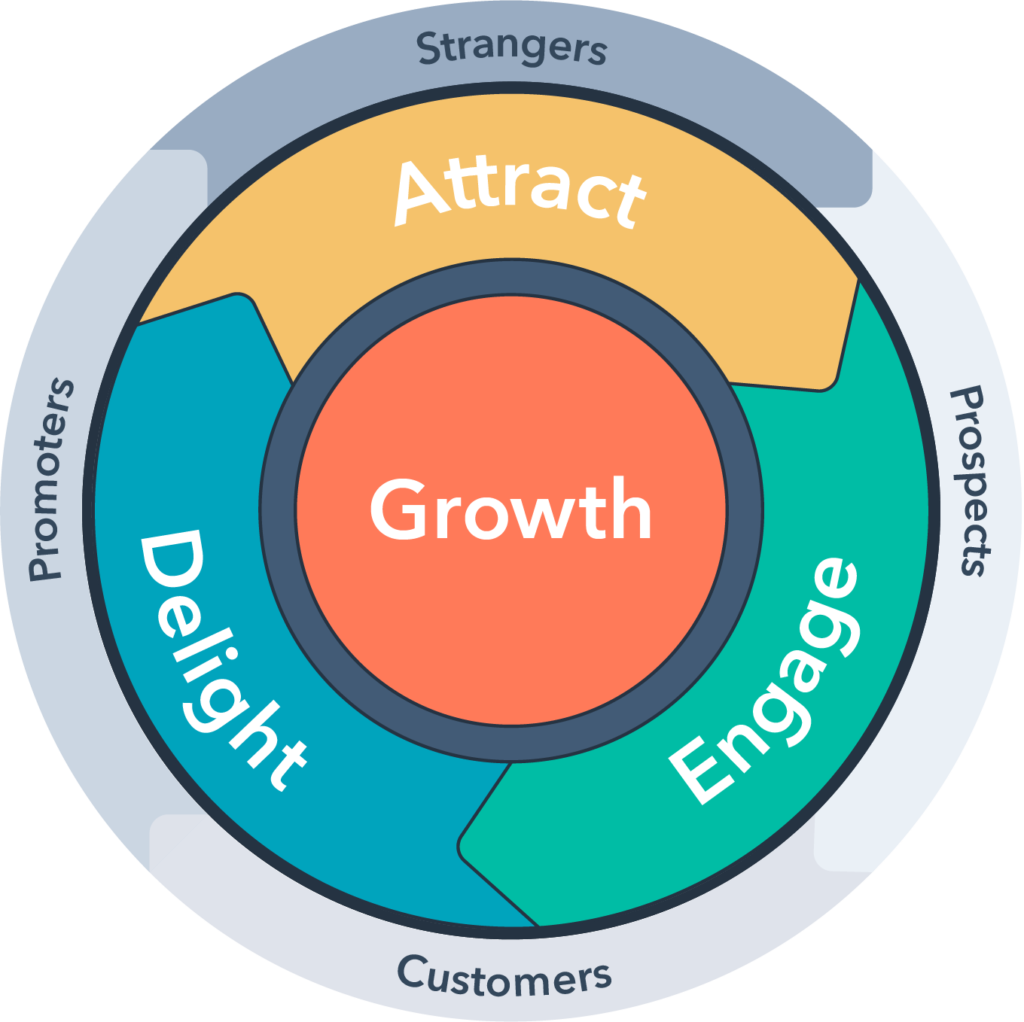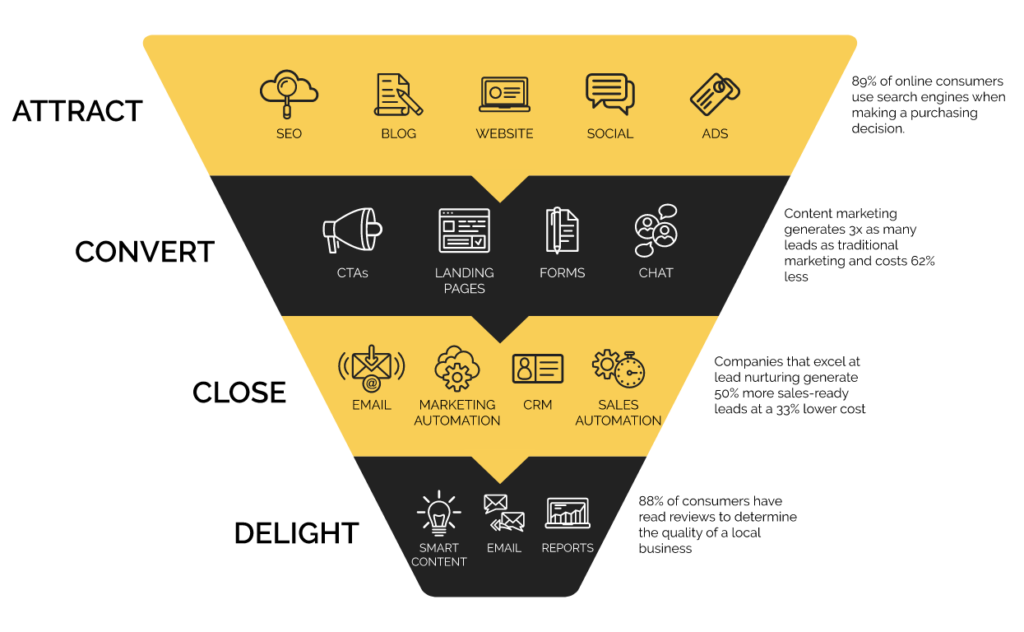Introduction to the Inbound Marketing Funnel

Table of Contents
- Introduction
- What is the Marketing Funnel
- What is the Inbound Marketing Funnel
- Stages in Inbound Marketing Funnel
- Key Takeaways
- Conclusion
- FAQs
What is inbound marketing? Inbound marketing is a business strategy for attracting customers by providing pertinent information and tailored experiences.
While outbound marketing bombards your audience with messages they don’t always desire, inbound marketing creates relationships and addresses problems that your audience already has.
Examples of outbound marketing include:
- TV and radio commercials
- Telemarketing
- Banner and display advertisements
- Billboards
- Newspaper and magazine ads
- Cold calling
- Pop-ups and pop-unders
- Contextual ads
Whereas inbound marketing includes a form of marketing that targets a particular group:
- Blogging
- SEO
- Opt-in email marketing
- Social media marketing
- Content marketing
- Use of influencers to sell products to a certain audience
Thus, outbound marketing entails reaching out to customers to pique their interest in a product. On the other hand, inbound marketing focuses on developing and sharing content that attracts visitors to your website. Social media posts, blogs, reports, webinars, and other interactive types of content are available.

What is the Marketing Funnel?

A good next question here would be, what exactly is a marketing funnel?
Let’s take an example here. You have a Paper Company. Your clients may be limited to schools, corporates, and businesses in this declining market. A school hears about your paper company, and they want your business. A marketing funnel is exactly this. It is the customer’s journey with your group, starting from when they hear about your company to the point where they purchase your product.
Depending on your consumer base, your marketing funnel may vary. B2C clients frequently explore the funnel on their own or with the help of trusted advisers such as family and friends. B2C customers are unlikely to contact a corporate person directly. Customers that do business with you have larger, more targeted buying groups. In the lower phases of the marketing funnel, B2B customers contact directly with sales personnel. Adjusting your funnel to fit your user personas improves its efficiency right away.
What is the Inbound Marketing Funnel?
What is a funnel, by definition? A funnel refers to a pipe or tube wide on the starting end and narrows on the other end. In an inbound marketing funnel, the prospects are narrowed through checkpoints or inbound marketing funnel stages.
The active research process (or phases) someone goes through leading up to purchase is visually represented by the inbound marketing sales funnel. The inbound methodology marketing team may use this technique to attract visitors to your website, turn them into qualified leads, close sales, and delight customers.
If you’re familiar with the conventional marketing and sales funnel, you’ll recognize the inbound marketing funnel. Brian Halligan, the co-founder of HubSpot, recently developed a new paradigm called the inbound marketing flywheel. This strategy focuses on aligning your business strategy to provide an outstanding client experience. The quantity of energy, or momentum, contained in your flywheel is determined by three factors:
- How quickly you spin it
- What is the amount of friction?
- What is its size?

The most successful businesses will adapt their company strategy to handle all three of these issues. When you apply force to the regions that have the most impact, the speed of your flywheel rises. Forces are the programs and tactics you use to increase the speed at which your flywheel spins. Inbound marketing, a freemium model, frictionless selling, a customer referral program, paid to advertise, and putting money into your customer support staff are all examples of forces.
Stages of an Inbound Marketing Funnel
Now, our strategy in the marketing world has gone through changes. Now, the newer four inbound marketing funnel stages are:
- Stage 1 – Attract
- Stage 2 – Convert
- Stage 3 – Close
- Stage 4 – Delight

Stage 1 – Attract
Attracting people to your website is the first step in the inbound marketing sales funnel. However, you don’t want to attract everyone. You want the appropriate people to come to your website. Your buyer personas, or ideal customers, are the proper visitors.
These are the individuals for whom you should be developing content, and customers in this stage often want to solve a problem, find an answer, or fill a need. Consumers are frequently bombarded by adverts and irrelevant material in today’s oversaturated market, making your work much more difficult. It’s critical to attract key consumers who you know desire or need your product or service, and the following are some of the finest ways to accomplish this:
- Creation of content: Make a blog as a source of content. The more you blog about things your target consumer is interested in, the more authority you’ll get in the industry. Make blogs that are entertaining, topical, and have a lot of information. The more material you have out there, and the more you promote it on social media platforms, the more customers you’ll reach, and the more likely they’ll visit your site to see what you’ve got to say.
- SEO: The more popular your site is with search engines, the more likely it is to be displayed to customers. Improve your SEO, and your internet search engine rating will rise. The higher you rank in the search engines, the more people will see your site, which means more strangers will become visitors. The best part is that SEO is completely free.
- Social media marketing: Social media platforms such as Facebook, Instagram, and LinkedIn offer extremely powerful advertising possibilities. The purpose of the attract phase is to raise awareness, so seek social media advertising strategies that may provide you with many impressions.
Stage 2 – Convert
You want to develop relationships with people who come to your website and transform (convert) them into leads. You must obtain contact information from visitors to convert them into leads, which is quite useful. On the other hand, visitors require something in return to offer you their contact information. This is when you should provide them with more high-quality material to help them make their selection. When it comes to converting visitors into leads, the following are some of the most crucial factors to consider:
- Landing pages: Those are websites that entice people to download or sign up for content offers such as e-books, newsletters, webinars, and free trials, among other things.

- Forms: You want to get visitors’ contact information, such as their name, email address, and phone number, in return for content or anything else of value. Your visitors will fill out forms in order to acquire that essential material.
- CTAs (calls to action): After seeing your material, provide text and/or a button on your website that tells the visitor what you want them to do next, such as purchase now or request a demo, urging them to take action or contact your company.
Stage 3 – Close
The inbound marketing funnel’s ‘Close’ stage is when you drive leads through the sales pipeline toward a final purchase decision. In many firms, converting a lead into a client may be lengthy. So, employing the following components, continue to provide helpful and relevant material to assist prospects in their decision-making journey:
- Lead fostering: Because leads are always at different phases of the purchasing process, you must ensure that the correct content is sent to the right people at the right time. This is referred to as lead nurturing. You can nurture prospects at every stage of their decision-making process using email, dynamic content, your website, and social media.
- Automated marketing: You can make the process smoother and more productive by using digital marketing technologies and tools to automate marketing operations. (HubSpot estimates that 68% of organizations employ automation in some form.) Consider adopting marketing automation platforms like HubSpot, Outgrow, or Percolate to automate processes like meeting scheduling, content distribution, contract production, emails, text messages, and even personal connection reminders for your sales force.
- CRM software: is a type of software that helps you manage your customer relationships. CRM software can assist you in better organizing and accessing prospect and customer information. Our customer, Aquila Commercial, has worked with IMPACT to achieve incredible results since implementing HubSpot for marketing and sales automation.
Stage 4 – Delight
Finally, you’ve converted a lead into a customer after a long journey through the inbound marketing funnel. You may now wash your hands of them because they’ve made a transaction. This client might be beneficial to you. What’s more, who’s to say they won’t buy from you in the future?
Customers pleased with your helpful service are likely to become your most enthusiastic boosters. They’ll give you five stars, tell their friends about you, and share all of your social media updates. If you’re nice to your customers, they’ll be nice to you. (It’s also much less expensive to keep consumers than it is to go out and get new ones.) Here’s how you can assist them:
- Email marketing: Don’t forget about your customers once they’ve completed a transaction. The more personal and specialized your follow-up emails are, the more likely they will make another purchase. Another technique to make your consumers into promoters is to ask for product feedback once they’ve got it.
- Exclusive, personalized messages: People want to feel like they’re receiving the inside scoop, so use exclusive, personalized messages. Those will start to speak if you have an exclusive newsletter for people who have purchased an item or service and if you give periodic special bargains. The better you treat your existing customers, the more likely they will tell their friends about you, re-starting the inbound funnel.
Key Takeaways
- Outbound marketing includes TV and radio commercials, Telemarketing, Banner and display advertisements, etc.
- Whereas inbound marketing targets a particular group; blogging, SEO, opt-in email marketing, social media marketing, etc.
- Thus, outbound marketing entails reaching out to customers to pique their interest in a product. On the other hand, inbound marketing focuses on developing and sharing content that attracts visitors to your website.
- Depending on your consumer base, your marketing funnel may vary. B2C clients frequently explore the inbound funnel on their own or with the help of trusted advisers such as family and friends, while B2B customers contact directly with sales personnel.
- An insight into inbound marketing flywheel, created by the co-founder of Hubspot This strategy focuses on aligning your whole business strategy around providing an outstanding client experience.
- Now, our strategy in the marketing world has gone through changes. Now, the newer four inbound marketing funnel stages are:
- Stage 1 – Attract
- Stage 2 – Convert
- Stage 3 – Close
- Stage 4 – Delight
Conclusion
Creating and optimizing a marketing funnel is the only way to survive in a competitive market. Even minor issues like font choice may influence conversions. And if you urge folks to buy from you too soon, they will go. Take the time to create a sales funnel that reflects your desires and those of your target audience.
Cultivate it over time, change your approach to different phases of the inbound sales funnel, and determine why your efforts aren’t yielding results.
FAQs
Inbound marketing connects a target audience with relevant information via natural channels such as search engines and social media sharing. A well-written blog article on a blogger’s favorite product, for example, will communicate to this potential buyer in a way that a banner ad cannot.
The several types of inbound marketing methods include:
– Videos
– Blogs
– Topic clusters and pillar pages
– Guides
– Ebooks
– Social Media
– Press Releases
– Infographics
– Newsletters
It’s the only inbound marketing approach that assures your content will rank high on Google unless you have access to Google’s ultra-secret algorithm.
Every stage of an inbound sales and marketing funnel provides value. Begin by creating a single generic funnel based on the typical buyer’s path. For each level, create three pieces of content. Calls to action, landing sites, and lead-nurturing emails should be used. It’s time to call it a day.
Both rely on strong content to attract customers. In reality, search engine optimization (SEO) is inbound marketing. The goal of SEO, or search engine optimization, is to increase organic traffic from web search engine rankings (namely, dominate search engines like Google or Bing).
Latest Blogs
Explore how Google’s 2025 AI search updates triggered ranking chaos. Learn actionable strategies to adapt your SEO for AI Overviews, zero-click searches, and SERP volatility. Stay ahead now.
Learn how to rank on AI search engines like ChatGPT, Perplexity, and Gemini by optimizing your content for authority, structure, and relevance. Stay ahead in AI-driven search with this strategic guide.
Explore the best healthcare SEO services for your medical practice. Improve online visibility and effectively reach more patients in need of your services.


